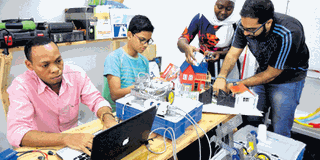Students learn to make robots at robotech labs

Soon as I entered Robotech labs located at Mindu Lane in Upanga, different robots were displayed all over the hub. On top of the tables, students and pupils were busy learning how to make robots with the help of their teachers seated next to them.
In Tanzania, Robotech labs is the first Robotics Academy which provides Science, Technology, Engineering and Mathematics (STEM) curriculum in the field of Robotics Education despite the growth of technology in the world.
Sharing the labs journey with Success which started in early August 2017 and currently has almost 30 students in 10 different courses, Shaukatali Hussein, Technical Director at the Robotech labs, says the hub was founded with the aim of driving ideas into reality and also to answer the curiosity and innovative ideas that had yet seen the light of day.
“Robotech also aims at helping and guiding young people in advancing their ideas to being applicable and implementable. Overall the goal is to make an impact, create a solution and make a difference in the platform of science and technology,” says Hussein.
The courses are Robochamp, Advanced Robochamp, Creo, Scratch, Robostar, Champion, Challenger and dual tone modulated frequency (DTMF) controlled robot. With the courses at the labs students learn to implement project based ideas, basic electronic components, mechanical, electronic, electrical concepts, power generation techniques, engineering and technology.
Courses cater to children from age 6 up to 18+ years old. For example, Robochamp suits children aged 6-9 years old and it is for 8 weeks. Here they are taught simple and powered machines. The basic concepts of mechanical engineering and electrical engineering are explained to them using fun elements and day to day examples.
“Here Students learn various STEM concepts and understand the how’s, why’s and what’s of engineering and mathematics. Students would make various designs as per the scientifically developed simple machine’s and enjoy their first ever experience on robots,” says Hussein.
Creo design engineer course caters to children from 10 up to 12 years old, also lasting for 8 weeks. With this course, pupils learn how to make various exciting and innovative designs using maths and science knowledge.
Hussein says designing in Creo 4 ignites students’ creative and innovative thinking. Designing in Creo 4 makes students understand mathematics and science, making them more interested in studies. They also learn what creo is and the terminologies used in creo, what 2D sketching is, how it is done in creo, sketching, editing sketches, how to apply constraining, datum, editing part model, dimensioning and many more.
Commenting on course ten DTMF for students of 18+, he says it lasts for 10 weeks, involving assembling the robot and operations, programming using arduino basic electronics, microprocessor and Microcontroller, DTMF module datasheet, connections and configurations and controlling through DTMF.
Ashirafa Ramadhan, an expert in Electronic and Telecommunication Engineering and a teacher at the Robotech lab for the past four months, says the labs teach children and grownups how to build robots. Ashirafa, who teaches mechanical, electrical and a little bit of programming, says that the robot comprises of four parts which are mechanical part, electrical part, electronics and programming.
“When you talk about electronics or mechanics, this is where you fix things and know exactly how you want your robot to look like, which is why we have robochamps. Currently my student (Kelvin) has finished five robochamps since February this year,” says Ashirafa.
Kelvin Kahesa, 11, is a standard VI pupil at Academic International School. He attends robot classes three times a week after class hours. His dream is to become an Electrical Engineer and owning and electronics company.
He was enrolled at the labs by his mother after learning about the labs from a friend he schools with. Since February he has built four rob champs. Being asked on how he has managed to create four robots in a short period of time he says, “I owe this achievement to my teachers, they are very supportive and encourage me to pursue my dream,” says Kelvin.
Commenting about Kelvin’s progress, his teacher Ashirafa says he is very creative and goes a step further when studying, he is not limited by what the teacher teaches in class. Through the challenges he was given he made a four wheel car robot from the components and connected four motors together.
Naggib Mohammed, 9, from Feza International School says Robotech labs is a nice place which has enabled him to build few robots and he calls upon other parents to enrol their children with the same interest at the labs as they get to meet new friends and learn how to create robots.
Issam Ngwalo is a teacher at the Robotech labs. He teaches coding. He says in the computer world there are two languages; high and low level languages. High level language is easy to be understood and low level is very difficult to understand.
He says, with his class he deals with high level language which helps students to create games, animations, and handling logic issues.
“Through our classes with pupils from 9-13 years we have managed to build a robot which detects an object in front of it and informs on everything that goes on with that object. These classes can help pupils learn exactly what they want to do in robots world, ” says Ngwalo.
With students the first module is purely mechanical. A soft and gentle introduction to get them acquainted with joining and assembling things together then followed by circuits where they are taught electrical and electronic components.
It is followed by soldering which involves joining the components on to a board together, the next stage requires students to build a robot by combining the first two modules. After that, basic programming starts. After this, programming is combined with other previous modules.
The labs also give project guidance to all engineering and diploma students who have to make a project in their final year.
Hussein says, “The labs have had students in their final year that either have to go for an internship or project. Mostly students choose projects to enhance and develop their skills for which they have approached us and we have guided them on how to start their project from component acquisition, understanding of how things work, to building it and finally testing it,” adding, “That way in the future when we work on developing real life solutions, we will be practically able to do so with this experience.”




